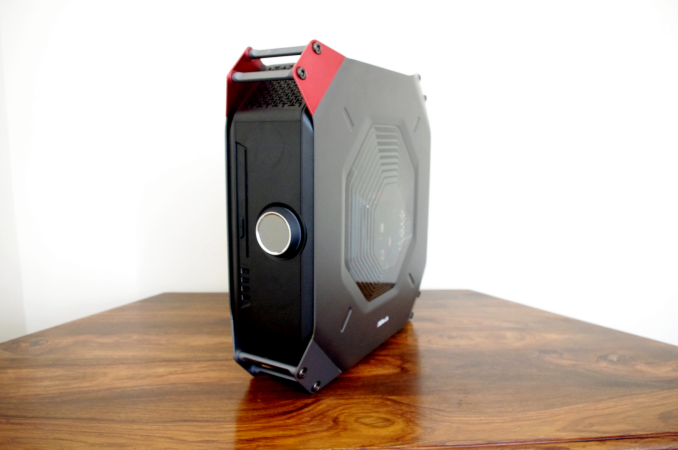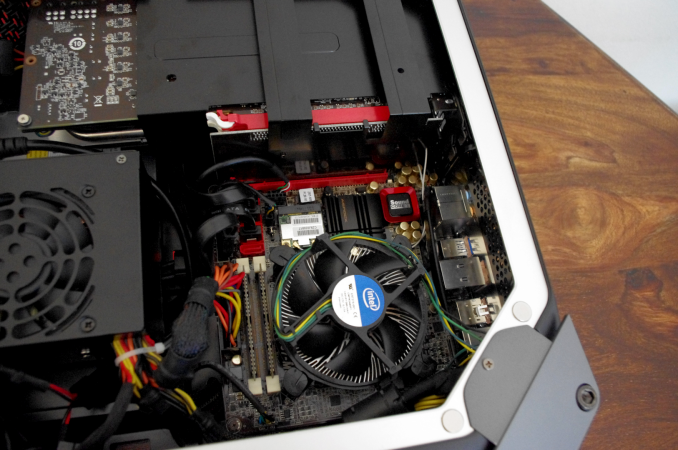ASRock M8 Barebones Review: My Steam Box
by Ian Cutress on January 2, 2014 10:00 AM EST- Posted in
- Barebones
- Intel
- ASRock
- Motherboards
- Cases/Cooling/PSUs
- Z87
ASRock M8 Conclusions: Recommended Steam Box Alternative
Small form factor systems that pack a punch is one of the ways this industry is moving forward. We only have to look at modern consoles and prebuilt systems like the Mac Pro to realize that people want everything smaller with no compromise in performance. Obviously going small means potential heat issues, and then everything centers on keeping the system cool, but also quiet. There is no point in having the world’s smallest computer and making it sound like a jet engine. Of course there are attempts underway to make the PC-you-play-next-to a thing of the past, with streaming from one device to another so heat and noise are no longer part of the equation (this means the realm of big boxes might come back). Nevertheless, there is and always will be a market for the box under the monitor/TV, and the ASRock M8 provides a small form factor system that can be as mobile as you like.
A lot of the buzz around the ASRock M8 will be the industrial design, and the fact that BMW’s design team had their inputs. I want to push that to one side, and take the system as it is – something elegant to look at that is easy to use and that provide sufficient power if a user wants to put the hardware together in order to do so. Using an 8-series platform means that small and large Haswell CPUs can take part, from the 15/25/35W parts all the way up to the full fat i7-4770K, although the 4-phase non-heatsinked solution might be cause for concern if a user wants to overclock. The 450W power supply is plenty for any GPU up to ASRock’s recommended 200W maximum, even though we topped out at ~250W at the wall under a GPU heavy load, meaning that I think that this PSU would handle 300W graphics cards – the only issue then would be heat removal.
In terms of air movement, the system allows a bottom to top air flow, giving the CPU cooling priority over the GPU. This could create issues if the system is placed standing up on a carpet, although the usual place for a console might be next to the TV providing the visuals on a TV stand, or this is the system that at a LAN would end up on the desk next to the gamer. The mobility is going to be one of the main draws of the ASRock M8 – the handles are built into the chassis and are sturdy enough to carry with one hand. Cases like the Bitfenix Prodigy are double the width and have flexible handles – the ASRock M8 solution is a step above this and even more so over handle solutions like the Lian Li TU-200/TU-100. The lock mechanism helps keep the magnetized side panels on, although using a generic lock system might not be the best thing for LAN events whereby some of the people at the event would have a similar locking device.
For hardware specifications, the front panel providing four USB 3.0 ports and a side loading ODD should be plenty, along with the fold out audio and card reader at the bottom. On the inside the motherboard has space for five storage devices whereas the case has room for four – this would allow a nice SSD boot drive and three storage 2.5” drives as necessary allowing the size of the case to not be a hindrance to storage. The motherboard comes with a dual band 2T2R 802.11ac WiFi module and Creative Sound Core3D which match the higher end for the M8 design (some users would point out that Core3D might not be ideal for them), and thankfully due to the nature of the case putting all the hardware in is actually very easy. The only issue I would like to point out is that the ODD color does not match the insides of the case, something which might want to be rectified. On the software side, ASRock bundle their usual BIOS/software combination along with a three month license of XSplit for game streaming. They missed out on an opportunity to do something unique on the M8 in this regard.
The price might remain as the final sticking point. $550 for what could be purchased for $350 (albeit a bit bigger and not as aesthetically pleasing perhaps) might seem a bit of an excessive jump, although I doubt $350 would get something this size and powerful. Take a look at the Tiki which Anand used as part of the GTX Titan release – it came on a granite base and cost a pretty penny. By comparison, the ASRock M8 is a good deal.
The best way to sum up the ASRock M8 is from the gift perspective: buying it will never put your machine on the top of the performance pile, but it does offer something different if you wanted to splash out on a case that remains mobile, or are building a system for a loved one and wanted an out-of-the-box solution that looks awesome.
I started this review mentioning Steam Box and then set about testing a $2000 solution, although removing some of the expensive items it could easily reduce down to sub-$1300 device that would play any Windows and Linux game with comparative ease. I tend to chop and change my PC a lot (I keep bouncing between small and super large every six to twelve months), but for my brother this would be perfect: he games, he goes to LANs, and he needs a bit of power. It would make a nice Christmas present for sure.
After all is said and done, the ASRock M8 is a very nicely built barebones that offers the opportunity to build a mobile gaming platform that should stand the test of time as well as providing nice aesthetics and industrial design. The price might not appeal to most in the bang-for-buck stakes, but ultimately that is not the real point of the M8 – power and size with design. For this, I would like to give the ASRock M8 an AnandTech Silver Award.
ASRock M8: AnandTech Editors’ Choice Silver Award
At AnandTech our rating system goes Platinum, Gold, Silver, and Recommended: Should ASRock release a future version with perhaps another couple of VRMs and a heatsink, it might have been considered for a higher award. I would very much look forward to an X79 platform (or Haswell-E) like this in the future. The main issue there would be heat removal, but I am sure some clever people might be able to figure that one out. Add in some Thunderbolt, Intel NICs, SATA Express – the list could go on to make the system future proof.














78 Comments
View All Comments
IanCutress - Friday, January 3, 2014 - link
How so? Please send me an email (ian AT anandtech DOT com) with suggestions and comments.Navvie - Friday, January 3, 2014 - link
BMW designed this? Clearly not the same guys who design their cars.... if their cars were this fugly, nobody would by them, ever.Also some of the sentence structures in this article are hard to read...
eg. "ASRock now come to the market with the M8 barebones based on a BMW design for the Z87 platform, at half the width of the Bitfenix Prodigy and a high build quality."
Makes me think the design for the case is based on BMW's design for the Z87. Some far off successor to their Z3 and Z4 cars.
"ASRock now come to the market with the M8, a barebones for their Z87 platform, designed by BMW." Would be better, but still not right.
CknSalad - Friday, January 3, 2014 - link
It's good to see the SFF market finally gaining much needed steam with intriguing products such as this one. That said, I honestly prefer small shoebox-sized cases like the sg05 or the small tower cases like the crowd-funded Ncase M1, which I actually currently own :D.I'm okay with mid-tower and full tower cases as there will always be a want/need for an enthusiast market, but the DIY desktop market really needs to start making a lot more M-Atx cases that are around the size of the Silverstone SG10 or TJ08-E. If more cases like the Asrock M8 come up, I'm sure that the desktop market will garner more interest from the Average Joe consumer.
ImSpartacus - Friday, January 3, 2014 - link
"The mini-ITX motherboard designed specifically for the chassis forgoes any significant power delivery and heatsink design, which is perhaps an oversight – for this build I went for a an i7 CPU but a low power 'T' model SKU so as not to overload or burn out the power delivery. ASRock state that the fans they supply below the motherboard help with the VRM cooling and thus nothing should stop a user placing an i7-4770K into the system, but overclocking longevity might be limited. I decided to apply some brain and use common sense for our test build here."This paragraph feels a little un-Anandtech.
I'm used to reasoned arguments supported by buckets of objective data. This paragraph feels further from that and closer to FUD territory.
Granted, I have no reason to agree or disagree with the point raised in that paragraph, but that's really the problem. For me, an Anandtech article educates its audience and let's the audience do most of the conclusion-determining.
kyuu - Saturday, January 4, 2014 - link
Can't say I agree. This is a tech blog, not a science journal. The writers' personal opinions and foibles come into play all the time, and that's fine.Death666Angel - Monday, January 6, 2014 - link
So he should have pushed the platform until it burns out to prove or disprove what they said? What exactly is the FUD part for you? Seems like he gave us the AsRock PR line and his assessment of it. Going much further would increase the cost and risk by quite a lot, something he probably thought was not needed, and I have to agree.ol1bit - Friday, January 3, 2014 - link
Seems pricey. I built a media/steam PC with Window 7 for much cheaper than that. Runs everything I want it to, plus is stylish. an i3, 4GB, Nivida 650.Case isn't made anymore, but can be seen here: http://www.amazon.com/gp/product/B000CQBISA/ref=oh...
Jonpet - Saturday, January 4, 2014 - link
What`s with that presentation? Please place common object for size reference in at least one photo!Thanks.CalaverasGrande - Saturday, January 4, 2014 - link
at that BOM it is almost getting into New Mac Pro price range.Though the comparable Mac would have less storage, but a better CPU and GPU (well...debatable).
It certainly would have faster ram and external connectivity.
Death666Angel - Monday, January 6, 2014 - link
How is 50% cheaper getting into Mac Pro price range?